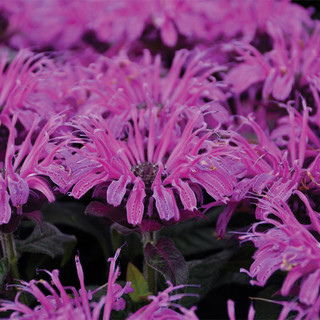
Elderberry Bushes
Uses:
- Specimen or Focal Point
- Container Gardens
- Garden Borders
Features:
- Unique Delicate Foliage
- Attracts Butterflies & Bees
- Can Produce Edible Berries
Sunlight:
- Partial Sun to Full Sun
- 5+ Hours of Direct Sun
Growing Zones:
- 3-7
- What is My Zone?
Elderberry shrubs are an ornamental shrub that can produce elderberries if cross-pollinated with another bush. These are often grown as just ornamental though, with delicate textured leaves that are very unique, along with beautiful flowers in the spring that contrast with the unique foliage.
Why Buy Elderberry Shrubs Online
Elderberry are a genus of flowering shrubs called Sambucus in the Adoxaceae family. The plants have delicate serrated leaves similar to a Japanese maple but in a wide range of colors from black to lime green. The bushes bloom in late spring, with large groups of small flowers in creamy white or sometimes pink. The flowers are followed by berries that are often black, dark blue or red. The berries are edible and have many uses once cooked. However, the rest of the plant is poisonous along with the berries when raw.
Elderberries typically grow from 3 to 12 feet tall and wide in a mounded form, however we do offer an upright version as well. Typically, you will need to plant more than one elderberry for cross-pollination and berry production. These plants are great for wildlife as they produce blooms and berries needed for pollinators like bees as well as berries for birds.
Use as an ornamental focal point
Great for birds, bees, and other wildlife
Available in black, green and lime green
Typically 3 to 12 feet tall
Growing zones 4 to 7
About Elderberry Bushes

Elder, Elder Tree, Black Elder, Common Elder
North America, Europe, Asia, and North Africa
Bushes
Deciduous
3 to 9
White, Cream
Late Spring to Early Summer
Multi-stemmed, Rounded or Sprawling
Pollinators (Bees, Butterflies), Birds
Wet Soil, Partial Shade
Deer
How To Use Elderberry In The Garden
Elderberries reward gardeners with tart black, blue, or red fruits treasured for jams, syrups, and cordials. The broad white flower clusters emerging in late spring can be used in cooking and fermentation projects. Many cultivars also boast colorful or variegated foliage, adding visual interest beyond harvest time. This perennial favorite contributes to local ecology by attracting pollinators and providing shelter for wildlife.
In landscape designs, elderberries function well as natural hedges or border shrubs, especially in spaces with partial sunlight. Their upright, multi-stemmed habit offers a striking backdrop in larger gardens, while also softening transitions between wild and cultivated areas. Plant them in groups to boost cross-pollination and enhance berry production. Occasional pruning of older canes supports healthy growth and a steady fruit supply.
Types of Elderberry Bushes
| Type | Scientific Name | Native Range | Flowers | Bloom Time | Habit | Zones | Features |
|---|---|---|---|---|---|---|---|
| American Elderberry | Sambucus canadensis | Eastern & central North America | Large, flat, creamy-white clusters | May – June (fruit July–Sept.) | Multi-stemmed, suckering shrub | 3 – 9 | Very cold-hardy; fruits tart, high in antioxidants; >50 bird species eat the berries |
| European / Black Elderberry | Sambucus nigra | Europe, N. Africa, W. Asia | Creamy-white umbels, sweet-scented | May – June (earlier than American) | Upright to arching shrub or small tree | 4 – 8 | Larger, sweeter berries; many ornamental leaf-color cultivars; principal species in elderberry supplements |
| Red Elderberry | Sambucus racemosa | N. America & Eurasia | Creamy-white conical clusters | April – May (fruits ripen early summer) | Upright, thicket-forming by root-sprouts | 3 – 7 | Bright red berries toxic raw to humans; most shade-tolerant elder; flowers before foliage of many shrubs |
Elderberry Care
Elderberries should be planted in full sun and in well-drained, moist, fertile soil with an acidic pH. Plant them 2 inches deeper than their nursery pot depth. Due to their shallow roots, elderberries require consistent deep watering, especially during the first two years. Fertilize plants in early spring with a high-nitrogen fertilizer.
Start pruning elderberries once they reach two years old in early spring. Begin by removing dead, broken, or weak canes, then eliminate canes older than three years to promote the growth of new, productive shoots. In autumn, clean up fallen foliage, apply mulch, and consider protecting the plant from rabbits with a hardware cloth cage if necessary. For container cultivation, select varieties that remain under five feet tall and ensure the container drains well.
Learn More About Elderberry Care

Elderberry Companion Plants
Plants that go well with elderberry are smaller shade loving plants that can grow underneath these large shrubs or other berry producing plants for wildlife. Some of our favorite plants to grow with elderberry are phlox, bee balm, winterberry and blueberry shrubs. Try and plant the other plants at the same time as the elderberry, because these shrubs do not like their roots to be disturbed once established.












